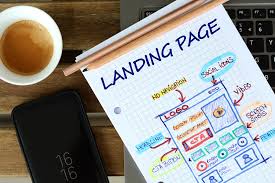The Art of Landing Page Optimization
In the realm of digital marketing, landing pages play a crucial role in converting visitors into leads or customers. A well-optimized landing page can significantly impact your conversion rates and ultimately drive business success. Let’s delve into the key strategies for effective landing page optimization:
Clear and Compelling Call-to-Action (CTA)
Your CTA should be prominently displayed and clearly communicate the desired action you want visitors to take. Use action-oriented language that creates a sense of urgency and entices users to click.
Concise and Relevant Content
Keep your messaging concise, focusing on the benefits of your offer and how it solves the visitor’s problem. Use engaging visuals, bullet points, and headings to make the content easy to scan and understand.
Mobile-Friendly Design
With an increasing number of users accessing websites on mobile devices, ensure that your landing page is responsive and optimized for mobile viewing. A seamless mobile experience can significantly improve conversion rates.
A/B Testing
Experiment with different elements on your landing page, such as headlines, images, CTAs, and forms, through A/B testing. Analyze the data to identify what resonates best with your audience and continuously refine your landing page for optimal performance.
Loading Speed Optimization
A fast-loading landing page is essential for retaining visitors and preventing bounce rates. Optimize images, minimize unnecessary scripts, and leverage caching techniques to ensure swift loading times.
Trust Signals
Incorporate trust signals such as customer testimonials, security badges, and social proof to instill confidence in visitors and encourage them to take action on your landing page.
Data-Driven Decision Making
Utilize analytics tools to track user behavior on your landing page, including bounce rates, click-through rates, and conversion metrics. Use this data to make informed decisions about further optimizing your landing page for better results.
By implementing these strategies for landing page optimization, you can enhance user experience, increase conversions, and maximize the effectiveness of your digital marketing campaigns.
Top 5 FAQs About Landing Page Optimization: Strategies and Best Practices
- What makes for a great optimized landing page?
- What two options are needed to optimize the landing page?
- What is a landing page in SEO?
- How do you optimize a landing page?
- What are two actions to optimize the landing page?
What makes for a great optimized landing page?
A great optimized landing page is characterized by a combination of key elements that work harmoniously to drive conversions and engage visitors effectively. It starts with a clear and compelling call-to-action (CTA) that guides users towards the desired action. Concise and relevant content that highlights the benefits of the offer and resonates with the target audience is crucial. Mobile-friendly design ensures seamless user experience across devices, while A/B testing allows for continuous improvement based on data-driven insights. Fast loading speeds, trust signals like testimonials and security badges, and a focus on data-driven decision making further contribute to making a landing page truly optimized for success.
What two options are needed to optimize the landing page?
To optimize a landing page effectively, two crucial options are required: clear and compelling call-to-action (CTA) and concise and relevant content. The CTA serves as the guiding force that directs visitors towards the desired action, while engaging content that highlights the benefits of the offer plays a pivotal role in capturing and retaining their interest. By combining a strong CTA with impactful content, a landing page can be optimized to drive conversions and achieve desired outcomes.
What is a landing page in SEO?
A landing page in SEO is a specific web page that is created to attract visitors through search engine optimization (SEO) efforts. Unlike regular web pages, a landing page is designed with a singular focus, often promoting a specific product, service, or offer. Its primary goal is to convert visitors into leads or customers by providing relevant information and a clear call-to-action. By optimizing the content and structure of a landing page for targeted keywords and user intent, businesses can improve their search engine rankings and drive organic traffic to the page, ultimately enhancing their online visibility and conversion rates.
How do you optimize a landing page?
Optimizing a landing page involves a strategic approach to maximize its effectiveness in converting visitors into leads or customers. To optimize a landing page, start by crafting a clear and compelling call-to-action (CTA) that prompts visitors to take the desired action. Ensure that the content on the landing page is concise, relevant, and focused on showcasing the benefits of your offer. Design the landing page to be mobile-friendly for seamless viewing across devices. Conduct A/B testing to experiment with different elements and refine based on data-driven insights. Prioritize loading speed optimization, incorporate trust signals, and make decisions based on analytics to continuously improve the performance of your landing page. By following these steps and adopting a holistic approach to optimization, you can enhance user engagement and drive conversions effectively.
What are two actions to optimize the landing page?
When looking to optimize a landing page, two key actions stand out: refining the call-to-action (CTA) and conducting A/B testing. Firstly, ensuring that the CTA is clear, compelling, and strategically placed can significantly improve conversion rates. A strong CTA prompts visitors to take the desired action, whether it’s making a purchase, signing up for a newsletter, or downloading a resource. Secondly, conducting A/B testing allows marketers to experiment with different elements on the landing page to identify what resonates best with the audience. By analyzing data from these tests, adjustments can be made to enhance the overall performance and effectiveness of the landing page.

